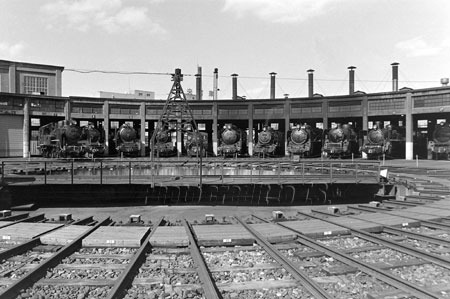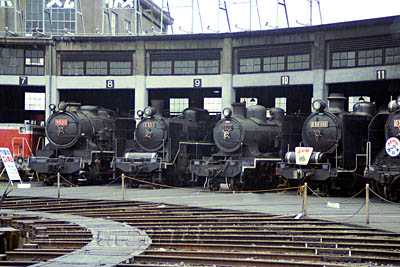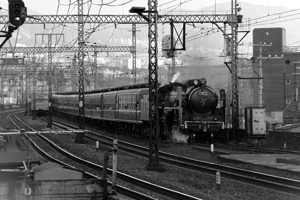The Umekoji Steam Locomotive Museum
My story .... behind the story
Part 2
.... to Umekoji Museum
|
Just a Umekoji museum opening one year ago on 1971.
Since a large number of engines were already concentrated at Umekoji,
fans asked the question........ Why ? Why ? That was the question on all of the fans minds ...... and what was the reason behind it all ? The concentration was so early..... of course, no one knew the answer, until an explanation from a Rail-fan magazine stated that it was for the filming of the railroads 100 year anniversary movie. The assembled mass of engines were different from the museum preserved engines, They were ; C11_96, C12_225, 48635, 9633, C50_154, C55_1, C56_107, C57_5, C58_80, C59_164, C61_2, C62_2, D50_140, D51_1, D52_140, D60_31 and D61_2. After the filming, they were returned to there own depots. After its opening in 1972, one could see the generalized form that the "Steam Museum" was to take. The first decision was..... which engines were going to be restored ? ..... and a decision was arrived at. For the most part, the original schedule was followed, except that the class C62 and C62_1 was changed to C62_2. The main reason rumored as to the change was, that the C62_2 had a Swallow symbol mark (Called Swallow Angel) on its smoke deflecter which had gained enormous popularity. Later, this rumor was declared to be wrong. And C50 was left out, due to a Subspecific class 8620. Japanese rail fans were disappointed when the B20 was selected over that of the C12... because many felt that the C12 would have been a more desirable selection. The reason was that the C12 had a better work history than the B20 in the opinion of the fans. And there was more shocking news, it was " Not all engines were intended for Restoration." Four engines, C51_239, C53_45, C59_164 and D52_468 would not be restored, only static exhibit. Mostly we wanted to hear the steam blast sounds, but because those four engines would not be restored .... many Japanese Rail-Fans were greatly disappointed. |

All exhibited engines on the first anniversary of Umekoji Museum. November 1973 |
|
But despite all this, Umekoji Steam Locomotive Museum was opened on 10 October 1972. The Opening-eve ceremony was held on October 9th 1972 from 1:00 p.m. At the beginning, JNR president Mr. Isozaki planted a memorial young black pine tree. The opening ceremony was conducted in front of the Symbol-Zone. The ceremony invited the Kyoto prefectural governor, Kyoto city mayor, and successive Umekoji depot directors, and one hundred and thirty other celebrities as well as eighty JNR members. After the JNR president's congratulatory speech, the naming ceremony was done. ..... it was named " The Umekoji Steam Locomotive Museum (Umekoji Jyoki Kikansha Kan). " The dedicated monument embodied the driving wheel from a C57_88 (Retired at 1st May 1972, Kii-Tanabe). There is an original English epitaph on the monument, as follows ; |
|
May the glory of steam locomotives over the past century be remembered and their gallant sight preserved here forever. 10 October 1972 Japan National Railways. |
|
At the end of the ceremony, a special ceremonial train was run.... it was the C62_2.
On the first day of its opening on October 10th 1972 at 9:30 AM.... a line of one thousand individuals were already in line... many of whom had been there throughout the night. At 9:30, the Chief Director Mr. Moriyama and Associate Director Mr. Yamagami conducted the ribbon-cutting. On its opening day the greater-than-expected visitors numbered more than 12,000 which necessitated periodic closings of the main gate for a more effective crowd control. The admission charge ran as follows : Adults 100 yen (about 1 USD) and Children 50 yen. However, these days the price has increased to 400 yen for adults and 100 yen for children (2008).
However, in the end, the steam train services were slowly decreased, eventually almost none ran even on the Sanin line. There were a number of reasons, for example, how to keep a turntable, coal bin, water tank and their effect on regular trains, as well as safe guards on city sections etc .... After starting, such problems appeared. Inevitably, maintenance problems arose in regard to active-preservation engines. The reason was that JNR workshops slowly shut down, insofar as steam maintenance was concerned. Both Umekoji maintenance shops and the Nagano works closed down for steam maintenance, as well as, other workshops. As a result, Umekoji working condition engines dropped off fire one by one, as well as other inactivated engines. " Engines could no longer kept in working condition ", which raised a chorus from Japanese rail fans. Five engines .... B20_10, C55_1, C59_164, D50_140 and D52_468 were dropped from the working condition on 28 March 1979. However, it soon followed that many of the problems were worked out. Moving to more suitable local lines, settled problems in regard to steam train service. One problem that arose was at the Takatori works and on going maintenance needs after the closing of the Nagano works. However, problems were gradually reduced and maintenace needs were met. In January 1995, a devastating earthquake occurred in the Kobe-Osaka area of Japan with resultant damage to the Takatori works, resulting with its closing. As a result, Umekoji museum assumed maintenance responsibility and maintenance needs were met internally. Eventually, steam train service restarted on the Yamaguchi line from August 1979, and C56_160 and C57_1 remained active on that line. But engine affiliation remained with Umekoji ...... the engines returned to Umekoji in the off season. Afterwards during 28 March 1987, four more engines, 9633, C11_64, C58_1 and D51_1 lost their working condition. During February 1994, class C62 ..... C62_1 was moved from Hiroshima to Umekoji museum. During September 2009, class 1070, No.1080 was donated from the Nittetsu Co to JR-West, and exhibited at the Umekoji from the 14th of September 2009. So, there are a total of twelve static exhibit engines at Umekoji museum ; 1080, 9633, C11_64, C51_239, C53_45, C55_1, C58_1, C59_164, C62_1, D50_140, D51_1 and D52_468. And there are a total of seven working condition engines at Umekoji museum in 2010 ; B20_10 (Active-preservation revived in 2002), 8630, C56_160, C57_1, C61_2, C62_2 and D51_200.
|

Umekoji Museum during April 1988 From the left, 9633, C551, 8630, D50140 and D51200 |

Part 1
 |
| Top menu |
